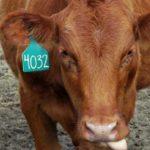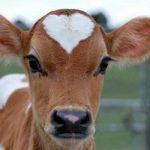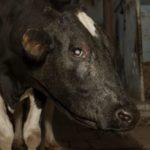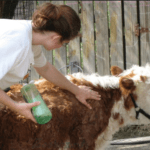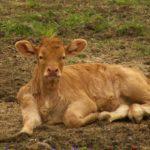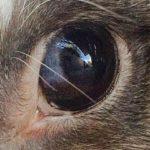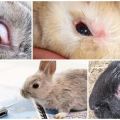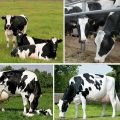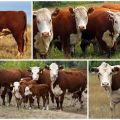Why a calf can watery eyes, frequent illnesses and treatment
A feature of the cow's eyes is their spherical shape and large size. The structure of the eyes of an animal and a person has a lot in common: the presence of the so-called protein, cornea, lens, retina, vitreous fluid. A common disease is also common - conjunctivitis. Other pathologies, as well as mechanical, chemical and toxic damage, can be the reasons why the calf has watery eyes.
Why do cow eyes water?
Conjunctivitis is the most common cause of watery eyes in a cow. Pathology is inflammatory in nature and develops as a result of the accumulation of bacteria in the lacrimal sac.
Factors contributing to the onset of the disease:
- sharp temperature drops;
- lack of nutrients;
- weak protective functions of the body;
- getting an infection in the eyes;
- mechanical damage to the mucous membrane;
- irritation of the conjunctiva due to chemical contact with the eyes;
- accumulation of dirt in the conjunctival sac;
- improper work of the lacrimal gland;
- allergy to high protein content in the tear fluid;
- strong drying of the conjunctiva, as a result of which pathogenic bacteria begin to multiply on the surface of the eye.
The following diseases can cause red eyes in newborn calves or in adults:
- Keratitis. Inflammation of the cornea.
- Belmo (leukoma). Clouding occurs as a result of the proliferation of tissues covering the eyes, which leads to a violation of the integrity of the membrane and the appearance of scars. The fabrics are layered on top of each other and do not let light through - the calf cannot see anything.
- Telyaziosis. It develops as a result of infection by helminths (nematodes). Infection usually occurs in the summer.
- Inflammation of the eyes due to bacteria carried by flies and ticks. In the summertime, parasites often infect the eyes of animals.
- Chlamydia, catarrhal fever, smallpox and other infections.

The cow's eye shell is often exposed to internal and external negative factors:
- non-closing of the eyelids due to the fact that the calf damaged them;
- metabolic disorders and diseases of internal organs;
- irritation of the conjunctiva with substances that fill the ambient air (due to poor cleaning of the room, lack of ventilation, smoke, spraying disinfectants, etc.);
- the development of a fungal infection that gets in with rotting food, bacteria that accumulate in the conjunctival sac.
The following factors contribute to the appearance of a cow's eyesore:
- Strong intoxication of the body.
- Infectious diseases.
- Contact with pathogenic microorganisms.
- Telyaziosis. The helminth enters the eyeball, disrupting its integrity.
- Erosion of the stratum corneum due to mechanical damage (trauma, burn).
- Incorrect eyelid structure (pathology can be congenital or acquired). For example, non-closure of the eyelids.
- A sudden increase or decrease in intraocular pressure.
- Autoimmune diseases.
- Age-related changes.
How to diagnose the disease
The presence of a problem in a cow can be determined by the corresponding signs.
Conjunctivitis is characterized by symptoms:
- redness of the affected area under the eyelids;
- redness of the inner surface of the eyelid;
- in some cases, damage to the cornea (gives the diseased area a lilac shade);
- swelling of the conjunctiva;
- clouding of the shell (leukoma has a characteristic light color, which becomes yellowish over time);
- the cow has difficulty opening the sore eye;
- lacrimation is observed;
- photophobia;
- itching;
- involuntary muscle contraction.
The development of a cattle squirrel is preceded by symptoms:
- severe lacrimation;
- conjunctivitis;
- swelling of the eyelids;
- photophobia (due to increased sensitivity of the pupil);
- redness of the membrane of the eye.
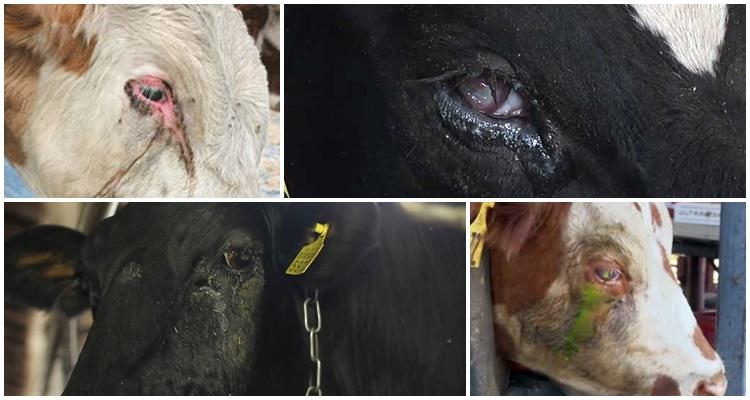
Thelaziosis is characterized by the following symptoms:
- inflammation of the conjunctiva;
- suppuration;
- clouding;
- pain in bright light;
- discharge of tear fluid.
With keratitis, there is profuse lacrimation, clouding of the lens, photophobia. Only an experienced veterinarian can make an accurate diagnosis after a careful examination.
Treatment of eye diseases in cattle
It is not difficult to treat conjunctivitis at first. If you rinse your eyes in time, the disease will disappear in a couple of weeks. When a cow's eyes fester, complex treatment is necessary:
- washing with furacilin solution;
- applying medicinal ointments;
- the use of local anesthesia;
- antibiotic therapy.
In advanced cases, an operation is required to eliminate the accumulated pus and prevent the onset of blindness.
To treat thelaziosis in a cow or calf, you will need:
- antibiotics;
- rinsing with boric acid solution and potassium iodide;
- antiparasitic drugs ("Tetracycline", "Chlorophos").
With keratitis, rinsing with a solution of boric acid, orbital blockages, vitamin complexes are prescribed.
Products made on the basis of fish oil will help get rid of the leucorrhoea:
- "Lizol";
- "Ichthyol".
Potential danger
The greatest danger is rotting eyes (panophthalmitis is a purulent inflammation of all tissues). Treatment in this case is useless, and the only thing that can be done is to remove the affected eye.

Any advanced eye disease can lead to loss of vision. Even an ordinary allergy, which provokes profuse lacrimation and clouding of the membrane, causes partial blindness.
Problem prevention
The main measures for the prevention of eye diseases in cows are:
- Regular (twice a year) and total deworming of cows.
- Elimination of flies, ticks and other pests that carry diseases. Sheds are treated with chemical solutions.
- Vaccination.
- Keeping barns clean and dry. You need to remove manure 1-2 times a day.
- Regular eye checks.
- Make sure that calves and adult cows do not injure their eyes.
- Choose safe walking areas.
- Remove dangerous objects from the barns, which could damage the eyes of the cow.
- Give young animals "Tetramisole", "Albendazole".
- Isolate sick animals from the herd.
- Remove food leftovers in time.
- Provide quality and varied food.
- Use means to repel annoying insects.Treat the skin and eyes (it is important that the ointment does not irritate their sensitive surface).
- Shed floors should be wooden (this will help keep the room warm and reduce the risk of infections and inflammation) and have a slight slope (so that dirt and impurities can drain off).
If a cow has watery eyes, redness and suppuration, then this is a clear symptom of the disease. It is important to detect the problem in a timely manner and take action. Inaction will lead to the development of pathology and loss of vision. In addition, the entire herd may be affected, as some infections are easily transmitted from one animal to another. The cow should be treated by an experienced specialist.

